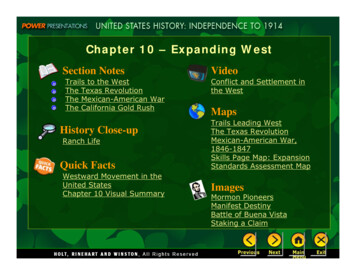
Transcription
Chapter 10 – Expanding WestSection NotesTrails to the WestThe Texas RevolutionThe Mexican-American WarThe California Gold RushHistory Close-upRanch LifeQuick FactsWestward Movement in theUnited StatesChapter 10 Visual SummaryVideoConflict and Settlement inthe WestMapsTrails Leading WestThe Texas RevolutionMexican-American War,1846-1847Skills Page Map: ExpansionStandards Assessment MapImagesMormon PioneersManifest DestinyBattle of Buena VistaStaking a Claim
Trails to the West8.8.2The Big IdeaThe American Westattracted a variety of settlers.Main Ideas During the early 1800s, many Americans moved west ofthe Rocky Mountains to settle and trade. The Mormons traveled west in search of religious freedom.
Main Idea 1:During the early 1800s, many Americansmoved west of the Rocky Mountainsto settle and trade. Some of the first Americans in the West were mountainmen: fur traders and trappers. Many settlers traveled west over the Oregon Trail. The Santa Fe Trail was another important path west.
Mountain Men Fur traders and trappers, who were some of the firstAmericans to explore the West John Jacob Astor created one of the largest furbusinesses, the American Fur Company. Astor founded Astoria, one of the first settlements inOregon Country.
Oregon Trail Settlers were lured by rich resources and the mild climate. The trail was 2,000 miles, beginning in Iowa or Missouriand ending in Oregon or California. Hard journey because of food shortages, bad weather, andmountains and rivers that were difficult to cross.
Santa Fe Trail The route led from Independence, Missouri, to Santa Fe,New Mexico. Was originally a Native American trading route Traders used the route to trade American goods forMexican goods; traders made high profits. Difficult journey due to hot desert and rough mountains
Main Idea 2:The Mormons traveled westin search of religious freedom. Joseph Smith founded the Church of Jesus Christ ofLatter-day Saints in western New York in 1830. Brigham Young became the new head of the church andmoved the group to Utah.
Mormons The Church of Jesus Christ of Latter-day Saints wasfounded by Joseph Smith in Western New York in 1830. Their book of religious teachings is called the Book ofMormon. Church members were persecuted due to some beliefs,including polygamy (1 man married to several wives). Joseph Smith was murdered by a mob in 1844.
Brigham Young New head of the church after Joseph Smith died Chose Utah as the group’s new home Thousands of Mormons took the Mormon Trail to Utah. By1860, there were about 40,000 Mormons there.
The Texas Revolution8.8.58.8.6The Big IdeaIn 1836, Texas gained its independence from Mexico.Main Ideas Many American settlers moved to Texas after Mexicoachieved independence from Spain. Texans revolted against Mexican rule and established anindependent nation.
Main Idea 1:Many American settlers moved to Texas afterMexico achieved independence from Spain. Father Miguel Hidalgo y Costilla, a Mexican priest, led an unsuccessfulrevolt against Spain in 1810. Mexico gained independence in 1821.– The new Mexican government hired empresarios, or agents, to bringsettlers to Texas. Stephen F. Austin, an agent, started a colony on lower the ColoradoRiver in 1822.– Success attracted more American settlers, who received free land inexchange for obeying Mexican laws. Mexico was concerned about the number of Americans and banned furthersettlement. General Antonio López de Santa Anna became the ruler of Mexico.
Main Idea 2:Texans revolted against Mexican rule andestablished an independent nation. War began October 1835 in a battle at Gonzales, Texas. Texans declared independence on March 2, 1836. The Republic of Texas was established. Sam Houston was named head of the Texas army. Stephen F. Austin went to the United States to seekmoney and troops.
Major BattlesBattle at the AlamoBattle of San Jacinto Texans’ actions angeredSanta Anna Santa Anna chased Texansunder Sam Houston Texas force of fewer than200, led by Colonel JimTravis, occupied Alamomission near San Antonio Texans took stand at SanJacinto River nearGalveston Bay From February 23 to March6, 1846, Texans held outagainst huge Mexican army All defenders killed inMexican attack on March 6 Houston’s forces attackedon April 21, 1836, anddestroyed Mexican army Santa Anna captured atBattle of San Jacinto andforced to sign treaty givingTexas independence
Independent NationSam Houston was the hero of the new independent nation ofTexas. Houston was elected president; Stephen F. Austinbecame secretary of state.To increase the population, Texas offered land grants to newsettlers. Many from nearby southern states brought enslavedAfricans with them.Most Texans hoped that the United States would annex, or takecontrol of, Texas and make it a state.President Jackson recognized Texas as an independent nation,but did not want to upset balance between slave and free statesby letting a slave state enter the Union.
The Mexican-American WarThe Big IdeaThe ideals of manifest destiny and the outcome of theMexican-American War led to U.S. expansionto the Pacific Ocean.Main Ideas Many Americans believed that the nation had a manifestdestiny to claim new lands in the West. As a result of the Mexican-American War, the UnitedStates added territory in the Southwest. American settlement in the Mexican Cession producedconflict and a blending of cultures.8.8.6
Main Idea 1:Many Americans believed that the nationhad a manifest destiny to claimnew lands in the West. Americans believed they could build a new, better societyfounded on democratic principles. The United States had a booming economy and population in the1840s.– Needed more space for farms, ranches, businesses, andfamilies– Looked to the West Some believed it was America’s manifest destiny, or obviousfate, to settle all land to the Pacific.– Question was whether slavery would be allowed in newterritories
Acquiring New Territory Democrat James K. Polk elected in 1844; favoredacquiring Texas and Oregon Oregon– Polk avoided war with Britain over Oregon andnegotiated treaty for land south of forty-ninth parallel– Oregon organized as territory in 1848 Texas– Texas annexed in 1845, but this action angered Mexico
California under Mexico Mexico had lost Texas but controlled other areas in the presentday Southwest—New Mexico, Arizona, Nevada, and California. The mission system was important in California, carrying outhuge farming and ranching operations using Native Americanlabor. Missions were broken up in the 1830s by Mexico.– Land grants given to wealthiest California settlers– Created vast ranchos, or ranches– Worked by vaqueros, or cowboys About 3,200 settlers, or Californios, were in California in theearly 1820s. Anglos, settlers from the United States, started to arrive in smallnumbers. They began calling for independence.
Mexican-American WarConflict Breaks Out The United States and Mexico were engaged in borderdisputes. John Slidell went to Mexico to try to buy New Mexico andCalifornia for 30 million. Mexican officials refused to speak tohim. Polk ordered General Zachary Taylor and his army into theborder region around the Rio Grande in 1846. U.S. troops clashed with Mexicans in April.War Begins Congress declared war on Mexico in April. Taylor’s forces won battles south of the Rio Grande in Mexico. General Stephen Kearny seized control of New Mexico.
Bear Flag RevoltSettlersOnly about 500 Americans were in Californiain 1846, in contrast to about 12,000Californios.RevoltAmericans seized Sonoma and declaredCalifornia to be an independent nation onJune 14, starting the Bear Flag Revolt.John C.FrémontFrémont, leader of a U.S. Army mappingexpedition, entered California to support itsindependence.U.S. ForcesU.S. naval and military forces invadedCalifornia in June 1846 and claimedCalifornia for the United States.
War’s EndBuena Vista General Taylor’s forces defeated the Mexican army under SantaAnna at Buena Vista in February 1847. The Mexican army had fled overnight. It was a fierce battle with heavy casualties on both sides.Veracruz General Winfield Scott’s forces seized the port of Veracruz inMarch 1847. Veracruz was the strongest fortress in Mexico.Mexico City Scott’s troops took Mexico City in September 1847 after a bravedefense by Mexican soldiers.
Main Idea 2:As a result of the Mexican-American War,the United States added territoryin the Southwest. Treaty of Guadalupe Hidalgo officially ended the war in 1848– Mexican Cession included present-day California, Nevada, andUtah, and parts of Arizona, New Mexico, Colorado, andWyoming– Mexicans in the cession areas were “protected in the freeenjoyment of their liberty and property, and secured in thefree exercise of their religion.”– Also included area claimed by Texas north of Rio Grande– Increased size of United States by almost 25 percent In the Gadsden Purchase of 1853, the United States paid 10million for southern parts of present-day Arizona and New Mexico.
Main Idea 3:American settlement in the MexicanCession produced conflict anda blending of cultures.Surge of American Settlers Americans flooded into theSouthwest. New settlers battled longtimeresidents to control land,water, and minerals. Most Mexicans, MexicanAmericans, and NativeAmericans faced legal,economic, and socialdiscrimination from settlers.Cultural Encounters Different cultures shaped oneanother in the Southwestdespite conflicts. Names of places showedHispanic and Native Americanheritage. Mexican and Native Americanknowledge and traditions alsoshaped many local economies.
The California Gold RushThe Big IdeaThe California gold rush changed the future of the West.Main Ideas The discovery of gold brought settlers to California. The gold rush had a lasting impact on California’spopulation and economy.8.8.38.8.58.9.4
Main Idea 1:The discovery of goldbrought settlers to California. California controlled by Mexico before Mexican-AmericanWar Population was mostly Mexicans and Native Americans Mexican officials gave Swiss immigrant John Sutterpermission to found a colony there in 1839.– Became a popular rest stop for immigrants Donner Party: group of early settlers traveling toCalifornia in 1846 that became lost in the Sierra Nevadaduring heavy snows and lost 42 of 87 members tostarvation
Gold in California Gold was discovered at Sutter’s Mill in January 1848. About 80,000 gold-seekers came to California in 1849;they were called forty-niners. They would prospect, or search for gold, along banks ofstreams or in surface mines. Placer miners used pans to wash gold nuggets out ofloose rock and gravel. California produced 60 million in gold in 1853.
Life in the Mining Camps Mining camps sprang up wherever enough people gathered tolook for gold. Miners came from many cultures and backgrounds.– Most were young, unmarried men in search of adventure.– 80% were Americans; the rest came from around the world.– Only 5 percent of gold-rush immigrants were women orchildren.– Women generally made good money by cooking meals,washing clothes, and operating boardinghouses. Miners paid high prices for basic necessities because the hugeamount of gold in circulation caused severe inflation in California.
Westward Movement in the United StatesCausesEffects Americans believe in ideaof manifest destiny Native Americans areforced off lands United States acquires vastnew lands in West Americans travel west tosettle new areas Pathfinders open trials tonew territories United States stretches toPacific Gold is discovered inCalifornia California experiencespopulation boom
Immigrants to California The lure of gold attracted miners from around the world. Many Chinese men came in hopes of making great wealthand then returning to China—about 24,000 from 1849 to1853. Many Americans did not welcome the Chinese, but theChinese still worked in gold mines, opened their ownbusinesses, and held other jobs.– In 1853, California placed a high monthly tax on foreignminers.– The legal system favored Americans over immigrants. In 1849 alone, about 20,000 immigrants arrived inCalifornia from China, Europe, Mexico, and South America.
Main Idea 2:The gold rush had a lasting impact onCalifornia’s population and economy.Population Boom Population explosion quickly made California eligible forstatehood Became 31st state in 1850 Growth had negative effect on Californios and NativeAmericans in CaliforniaEconomic Growth New businesses and industries transformed California. Completion of transcontinental railroad in 1869 endedisolation from rest of country and aided economy
The ideals of manifest destiny and the outcome of the Mexican-American War led to U.S. expansion to the Pacific Ocean. Main Ideas Many Americans believed that the nation had a manifest destiny to claim new lands in the West. As a result of the Mexican-American










